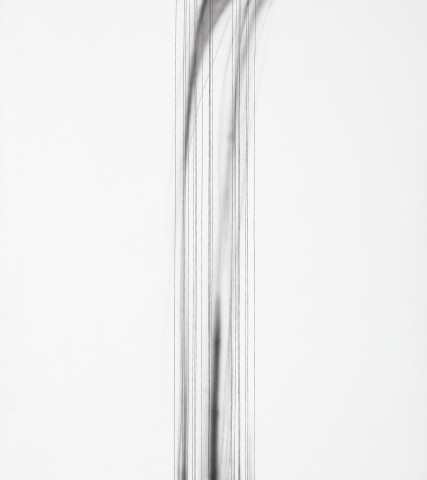STROKE, 1975
HOWARD ARKLEY
synthetic polymer paint on canvas
184.5 x 163.5 cm
Tolarno Galleries, Melbourne
The National Australia Bank Art Collection, acquired from the above in 1975 (label attached verso)
Howard Arkley, Tolarno Galleries, Melbourne, 23 April – May 1975, cat. 4 (as ‘Static/Dynamic Opposition, 1974’) or 5 (as ‘Impetus’)
The Seventies: Australian Paintings and Tapestries from the Collection of National Australia Bank, National Gallery of Victoria, Melbourne, 15 October – 28 November 1982
Howard Arkley - It's In The Can, Monash University Gallery, Melbourne, 8 October - 30 November 1991
Lindsay, R., The Seventies: Australian Paintings and Tapestries from the Collection of National Australia Bank, The National Bank of Australasia, Melbourne, 1982, pl. 2, p. 15 (illus.)
Taylor, P., Anything Goes: Art in Australia 1970 – 1980, Art & Text, Melbourne, 1984, p. 185 (illus.)
Hart, D., William Delafield Cook, Craftsman House, Sydney, 1998, p. 119
Howard Arkley Online Catalogue Raisonné: [https://www.arkleyworks.com/blog/2009/11/11/stroke–1975/] (accessed 22/11/21)
Seltsamer, 1975, synthetic polymer paint on canvas, 183.2 x 163.8 cm, in the collection of the Castlemaine Art Gallery, Victoria
While seemingly far-removed from the high-keyed riotous colour of Howard Arkley’s signature works, with their airbrushed black outlining and strong areas of patterning and decoration, in Stroke, 1975 we can already witness Arkley’s ability to knowingly push accepted conventions. Painted during a time in which American art critic Clement Greenberg’s formalist agenda still held considerable sway, Arkley’s introduction of airbrushed gestural elements into a ‘flat’ abstract painting entirely devoid of the creator’s hand, subtly conveys the sense of an artist who is uninterested in playing by the rules. Arkley’s monochromatic work like Stroke, produced from 1974 – 76 (with the works on paper continuing to 19781) drew on a vast array of sources, ranging from modernist art theory, philosophy and science and eastern spiritualism to the influence of a variety of artists, including Malevich, Robert Morris, and Arkley’s Australian contemporary, Robert Hunter (1947 – 2014). This grab-bag approach to inspiration, drawn from ‘high’ and ‘low’ culture and the everyday, were to remain a key characteristic of the artist’s work throughout his all-too brief but prolific career.
Stroke was included in Arkley’s first solo exhibition at George Mora’s Tolarno Galleries in St Kilda in April 1975, just two years after he had completed a Diploma of Art & Design (Painting) at Melbourne’s Prahran College of Advanced Education.2 This exhibition showcased Arkley’s now celebrated ‘White Paintings’, which he had commenced in 1974, comprising a sophisticated and elegant investigation of the possibilities of contemporary abstraction and mark-making within the self-imposed parameters of a palette restricted solely to black and white. This was an important formative time for the artist and, as his sketchbooks and drawings from the period attest, one in which he could freewheel and experiment, developing upon the intellectual and social movements he was introduced to during his studies (feminism, conceptualism and elements of 1970s avant-garde practice and theory3). Returning in 1981 to the statement he penned to accompany the exhibition, Arkley wrote: ‘… The selection of elements in my paintings is taken with great restraint. I slowly introduce basic plastic elements in a meditative way. I would like to be aware of every possibility before proceeding with new moves. I would like to work with a computer. Line: fat/thin. Tone: monochromatic/colour. Texture: soft/hard. Shape: Square/round. Movement: static/dynamic. etc. Through following these ideas I have been able to identify and use a strong personal feeling towards line. I draw rather than paint’.4
Arkley was invited to join Tolarno’s stable of artists the year after this first exhibition, introducing him to senior Australian figures such as John Brack (1930 – 99), along with a coterie of artists including Juan Davila and Constanze Zikos, who would go on to play important roles in his life as both friends and collaborators.
1. See Arkley Works, https://www.arkleyworks.com/white-works-on-paper-c-1974-78/ (viewed 11 December 2021)
2. Stroke may have been exhibited under another title in this first Tolarno exhibition. See Arkley Works: https://www.arkleyworks.com/blog/2009/11/11/stroke-1975/
3. Gregory, J., Carnival in Suburbia: The Art of Howard Arkley, Cambridge University Press, New York, 2006, p. 2
4. Arkley, H., ‘Artist’s Statement’, The Seventies: Australian Paintings and Tapestries from the Collection of National Australia Bank, National Bank of Australasia, Melbourne, 1982, p. 15
KELLY GELLATLY
